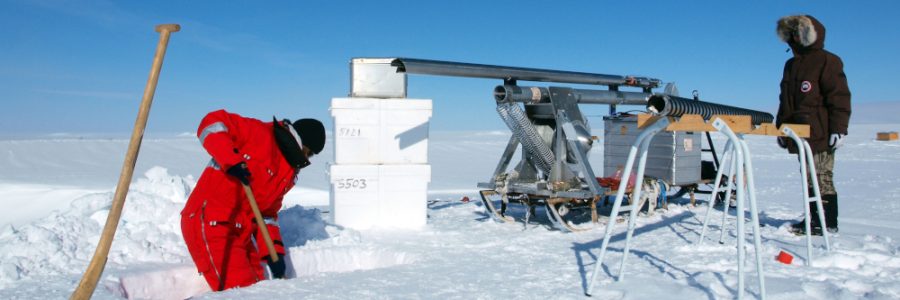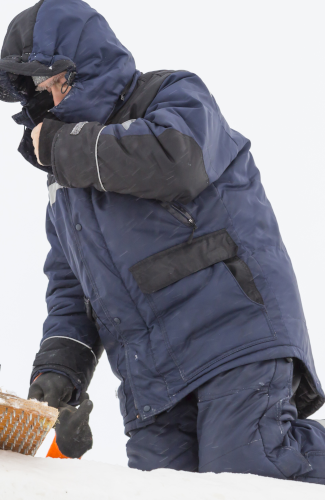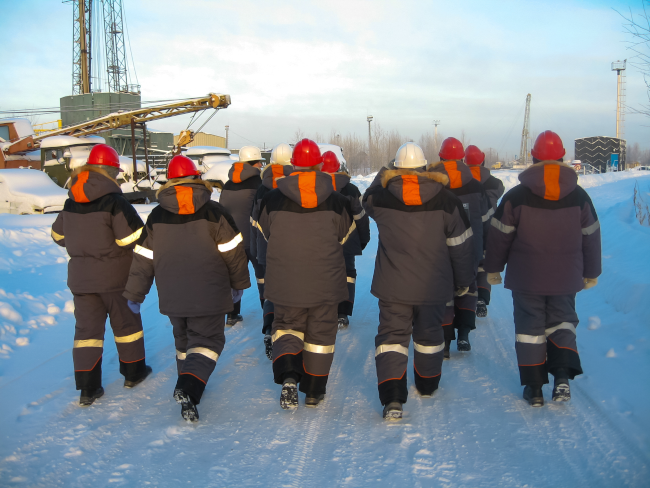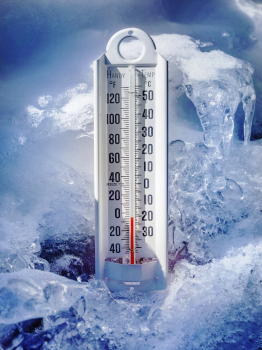
Keeping Safe in Hazardous Cold Weather
By Jerome E. Spear, CIH, CSP, FAIHA
When the National Science Foundation’s Office of Polar Programs organizes a team to travel to the Antarctica to drill ice cores, preparations are extreme. Drillers wear tight cuff wet gear over extremely cold weather gear as well as gloves, hoods, cold weather face masks and chemical vapor respirators. The latter to avoid exposure to some of the solvent like acetates used in ice drilling.
Moving into the warmer climate of Alaska, where the same drilling equipment is used as for normal well drilling, additional accessories are still required because of adverse weather conditions. Portable gasoline or diesel heaters are needed for both humans and equipment at the sites. Tents and sheds are erected to protect workers from cold winds and storms. In extremely adverse conditions, shelters are sometimes constructed over the drill site to both protect rigs and maintain comfortable working temperatures.
 Even in the dead of winter in the northern most states of the U.S., such extreme measures may not be necessary, but exposure to cold weather should never be taken lightly and always be prepared for. Many of the most useful measures to protect oneself from the cold are common-sense. Don’t wait for an unpleasant experience to err on the cautious side and select proper clothing for cold, wet, or windy conditions.
Even in the dead of winter in the northern most states of the U.S., such extreme measures may not be necessary, but exposure to cold weather should never be taken lightly and always be prepared for. Many of the most useful measures to protect oneself from the cold are common-sense. Don’t wait for an unpleasant experience to err on the cautious side and select proper clothing for cold, wet, or windy conditions.
Employers should have extra insulated clothing available for situations where temperatures drop unexpectedly below 40 degrees F. Layer clothing to adjust to changing environmental temperatures. Wear a hat and gloves in addition to polypropylene underwear that will keep water away from the skin. Take frequent short breaks in a warm, dry shelter to allow the body to warm up and perform work at the warmest part of the day. Use the buddy system and avoid exhaustion or fatigue because energy is needed to keep muscles warm. Drink warm sweet beverages like sugar water and sports drinks but avoid drinks with caffeine or alcohol and prepare for the cold with a warm high-calorie meal such as pasta.
Certain workers are more at risk of distress from cold exposure than others. These include individuals with predisposing health conditions, such as cardiovascular disease, diabetes, and hypertension. Also at greater risk are workers who are in poor physical condition, have a poor diet, are older or take certain medications. But all workers can be at risk of frostbite and even hypothermia if the conditions are right, but the preparations were not.

FROSTBITE
These are the warning signs of frostbite — deep layers of skin and tissue begin to freeze and the skin becomes hard and numb, its color pale or waxy white. The fingers, hands, toes, feet, ears, and nose are most typically affected by frostbite.
If frostbite is suspected, the person should be moved to a warm, dry area and not left alone. It’s very important that the frostbitten person does not try to rub the affected area because rubbing causes damage to the skin and tissue. Wet or tight clothing that may cut off the blood flow to the affected area should be removed and the area should be gently placed in warm (105-degree F) water. The water temperature should be monitored to slowly warm the tissue for approximately 25 to 40 minutes. Don’t pour warm water directly on the affected area because it will warm the tissue too quickly causing tissue damage. After the area is warmed, it may have a feeling of burning or numbness and may be puffy and blister. When normal feeling, movement and skin color return, the affected area should be dried and wrapped to keep it warm. The skin cannot be allowed to get cold again as this will cause severe tissue damage, and, of course, get medical attention as soon as possible.
HYPOTHERMIA
These are the symptoms of hypothermia — fatigue or drowsiness, uncontrolled shivering, cool bluish skin, slurred speech, clumsy movements or irritable, irrational, or confused behavior. The conditions for hypothermia can be deceiving, it can occur when land temperatures are above freezing, or water temperatures are below 98.6 degrees F. Cold-related illnesses can slowly overcome a person who has been chilled by low temperatures, brisk winds or wet clothing. When the body is unable to warm itself, not only can serious cold-related illnesses and injuries occur, permanent tissue damage and death may result. At 30 degrees F and no wind speed, skin can be exposed for an hour before it begins to freeze. When a 30 mile per hour wind is added to that 30 degrees, exposed flesh can begin to freeze within a minute.
 Hypothermia occurs when the normal body temperature drops to or below 95 degrees F. This is a medical emergency and 911 or an ambulance should be called right away. While waiting for emergency assistance, move the person to a warm dry area, remove any wet clothing and replace with warm, dry clothing or wrap in blankets. Have the person drink warm sweet drinks and avoid caffeine or alcohol. The person should try to move their arms and legs to create muscle heat, but if they are unable to do this, place warm bottles or hot packs in the arm pits, groin, neck, and head areas. As with frostbite, do not rub the body of a hypothermic person but unlike frostbite, do not place them in warm water as it may cause their heart to stop.
Hypothermia occurs when the normal body temperature drops to or below 95 degrees F. This is a medical emergency and 911 or an ambulance should be called right away. While waiting for emergency assistance, move the person to a warm dry area, remove any wet clothing and replace with warm, dry clothing or wrap in blankets. Have the person drink warm sweet drinks and avoid caffeine or alcohol. The person should try to move their arms and legs to create muscle heat, but if they are unable to do this, place warm bottles or hot packs in the arm pits, groin, neck, and head areas. As with frostbite, do not rub the body of a hypothermic person but unlike frostbite, do not place them in warm water as it may cause their heart to stop.
The drillers in the Antarctic prove that regardless of how cold conditions get, usually work can continue in a healthy and safe environment so long as one recognizes the environmental and workplace conditions that lead to potential cold-induced illnesses and injuries. This requires a workforce that is properly trained to learn the signs and symptoms of cold induced medical issues and what to do to help the worker if problems should occur.

25906 Nichols Sawmill Road · Magnolia, Texas 77355
Phone: (281) 252.0005 ·
www.jespear.com
Share This Article!

